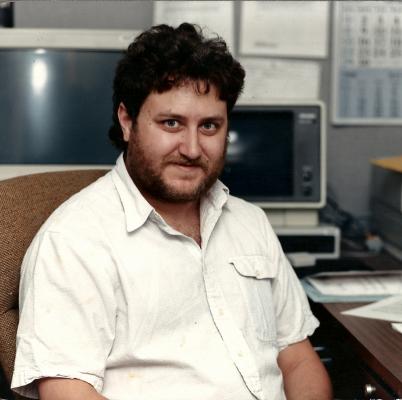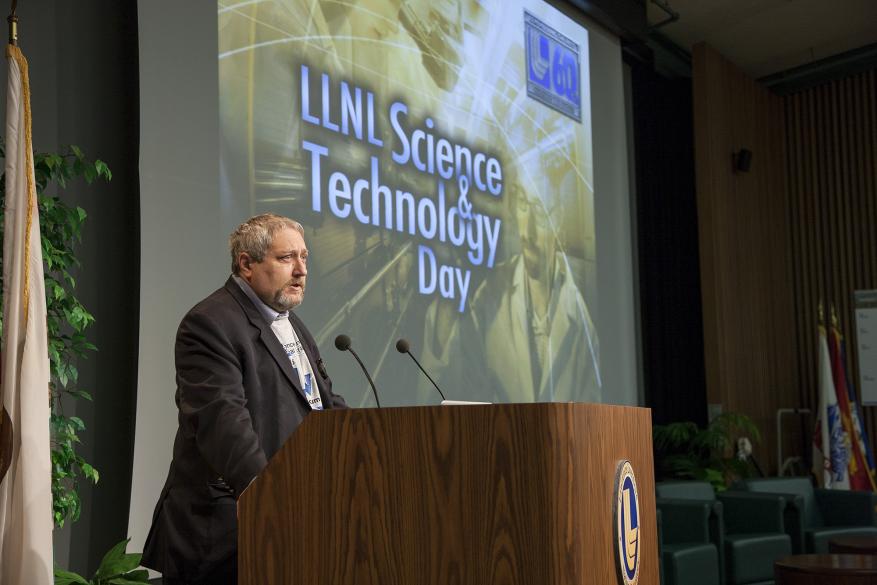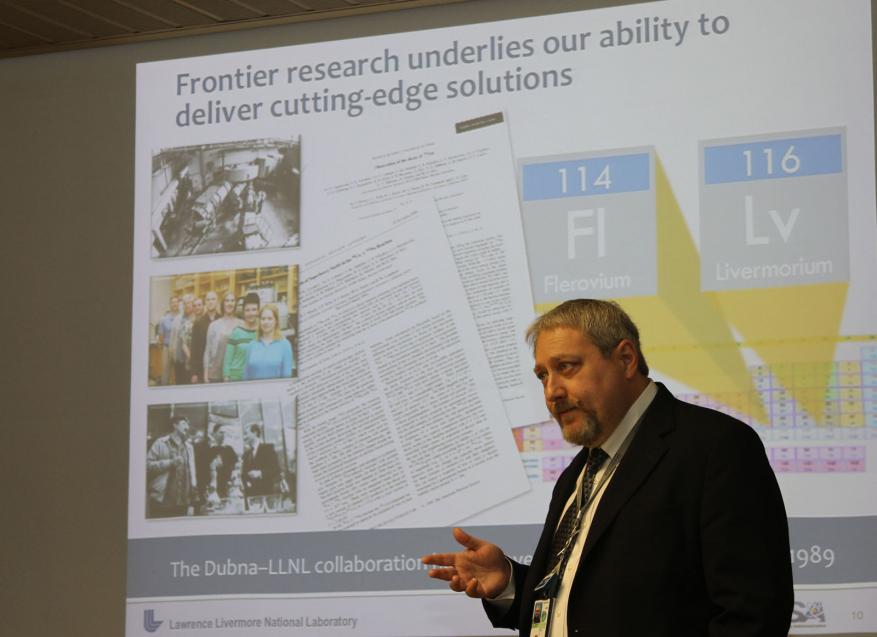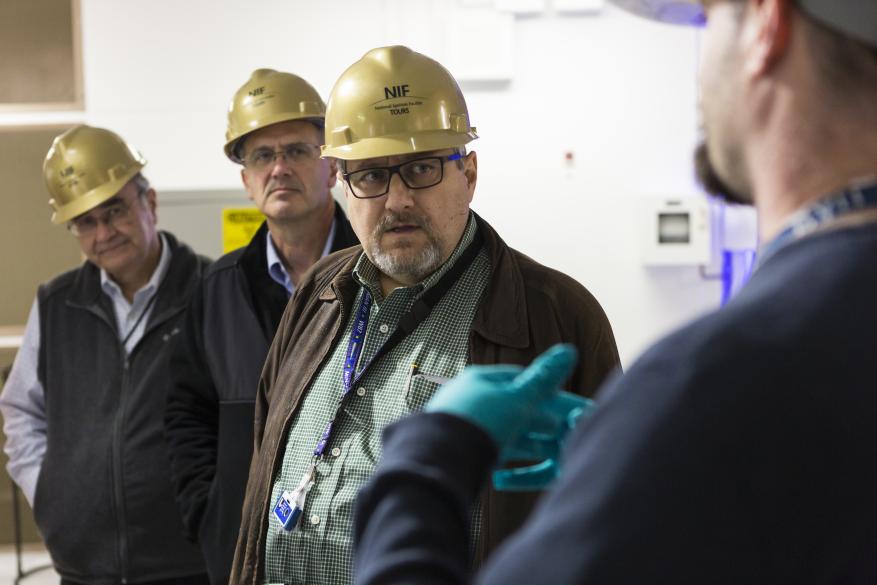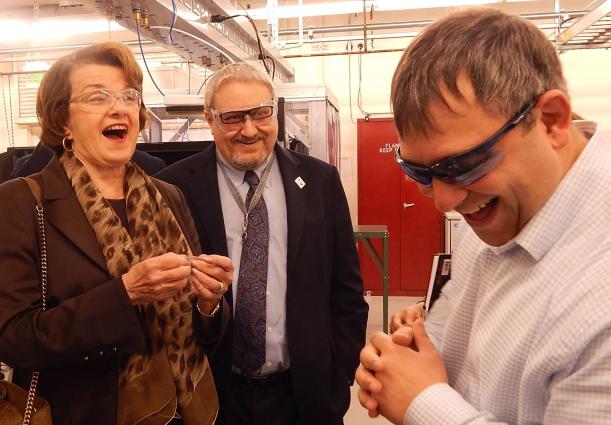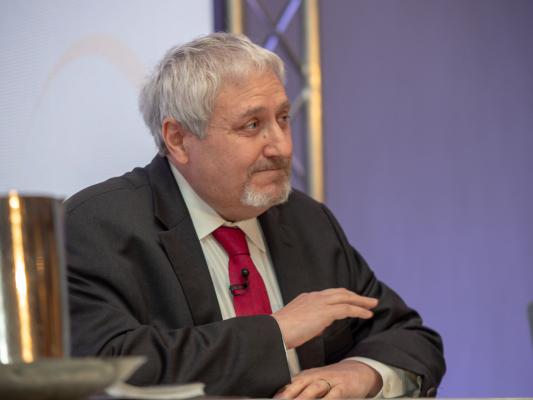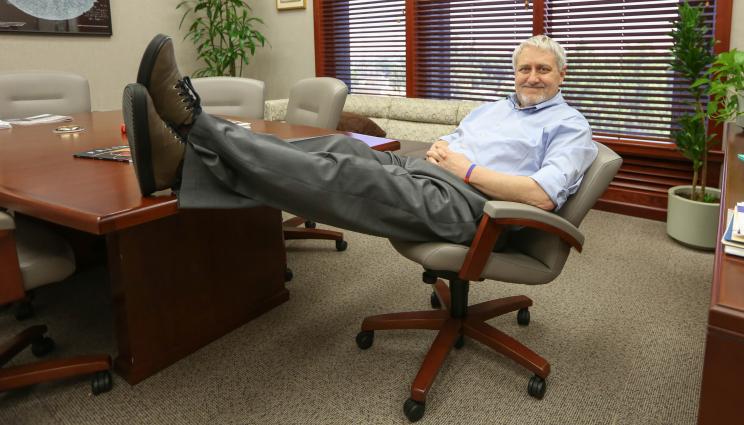
When he retires on March 1, Lawrence Livermore National Laboratory Director Bill Goldstein will conclude a distinguished 36-year career at the Lab, where he served as a physicist, associate director for Physics (Physical & Life Sciences), deputy director for Science and Technology and, beginning in 2014, as its director.
Nearly a year into piloting a major scientific institution through one of the most taxing and disruptive global events in modern history, outgoing Livermore Lab Director Bill Goldstein is ready for a vacation.
One of Goldstein's first orders of business following his retirement on March 1 is returning to the lush slopes, coffee plantations and sandy beaches of Kona, Hawaii, resuming a trip interrupted by the COVID-19 pandemic. After just two days on the island last spring, Goldstein was hastily called home to preside over what he calls the "most difficult sustained challenge" of his tenure.
"It's felt like an enormous responsibility," Goldstein said of shepherding the Lab through the pandemic. "I share with many employees the level of stress we've experienced the past year. It's certainly provided an added level of purpose to everything we've done, and at the same time, it's been an opportunity to be innovative and solve new problems, and to feel immense gratitude for being able to do everything we can to keep people safe. It's really brought home the importance of making safety a part of everything we do in a unique way."
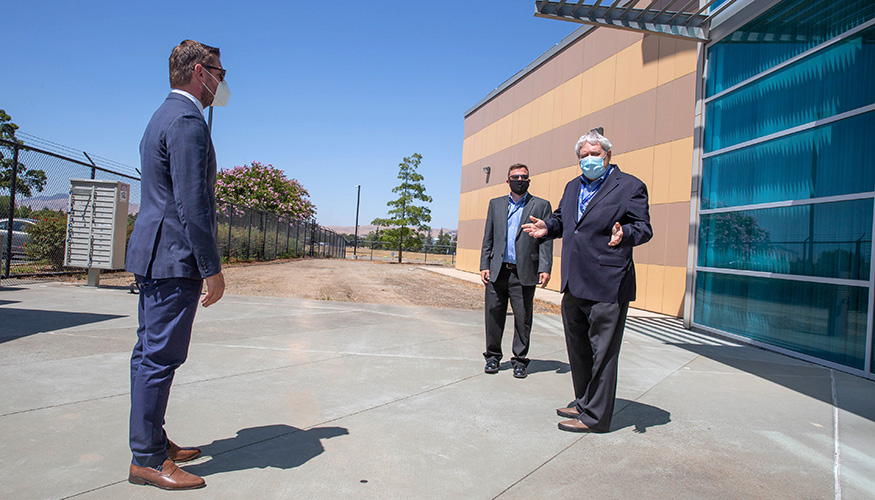
As the 12th director in the Lab's history, Goldstein faced myriad challenges in his almost seven years at the helm, including budget cuts at the National Ignition Facility (NIF), keeping exascale-class supercomputing on track and various scientific setbacks. But nothing could've prepared him for COVID-19, which had "no playbook," no precedent and little guidance from government authorities. The Lab's ability to sustain its performance though such a trying time, the unassuming Goldstein defines not as a victory for himself, but for the entire workforce.
"It's been personally gratifying and very exciting to see the Lab rise to the challenge," Goldstein said. "Like any large organization, it's not a given you're going to respond flexibly or nimbly to unexpected events. The fact we've been able to do that is a special tribute to the Laboratory. Everybody pulled together, were imaginative and managed to be productive and get things done despite all the obstacles and risks. There are many things I am proud of about the Lab over the past seven years, but this is certainly freshest in my memory."
Goldstein had decided to retire prior to the pandemic, but the ongoing crisis extended his stay, as he intended to allow enough time to find a suitable successor and for the Lab to return to operations with as little disruption as possible. As promising vaccines roll out, indicating, however cautiously, a light at the end of the tunnel, Goldstein feels the time is right to move onto his next chapter.
As he winds down the final days at his workplace for the past 36 years, Goldstein said he will miss a lot about the Lab - the daily commute from his home in San Francisco notwithstanding. His office, adorned with awards and memorabilia, its expansive windows offering a sublime view of the hills east of the city, is a world away from Long Island, New York where he grew up.
A lifelong pursuit of physics
Born in 1956, Goldstein's father was a civil engineer and his mother a schoolteacher, so education was emphasized throughout his childhood. A bright student who excelled at most subjects, Goldstein realized he wanted to pursue physics in high school, lured by the challenge of a field where success wasn't guaranteed.
"Once you start to learn about it, there's a tremendous amount of elegance there that is very aesthetically appealing," Goldstein said. "There are many opportunities for little successes when you understand something; that's one of the things I get a kick out of. Things in physics are fairly well-defined, so you know when you understand it. It's not like literature; you either get it or you don't. And when you do, you get a real kick out of it. On rare occasions, you can come up with things that no one's ever come up with before in quite the same way, and that's very exciting."
Goldstein followed his passion to Swarthmore, a liberal arts college in Pennsylvania, and then to Columbia University, where he earned his master's and Ph.D. degrees in theoretical physics. In 1982, Goldstein packed his bags for the West Coast, where he landed a prestigious postdoctoral position in the Stanford Linear Accelerator Center's Physics Theory Group and trained in elementary particle physics.
Joking that he had "no aptitude for laboratory or hands-on work," Goldstein gravitated to theoretical physics, which presented "no hazards for screwing up," and the ability to exercise his creativity. In 1985, Goldstein became attracted to the work going on at Livermore, where interest in the "Star Wars" X-ray laser was peaking. LLNL hired Goldstein into the Physics Directorate, where he joined a group working on plasma physics and plasma spectroscopy, with applications to the X-ray lasers.
"Scientifically it was an interesting prospect, and these were interesting times," Goldstein recalled. "There were opportunities here to get in on the ground floor on some new capabilities. It was completely new - I didn't know anything about atomic or plasma physics so it was a complete change of a field for me. In fact, I'd never used a computer until I worked here. I'd never done any programming or coding, and I started to do that for plasma modeling. I enjoyed it."
A "house theorist," Goldstein set about interpreting measurements that the weapons scientists were making in their experiments. With his Lab mentors providing cover, Goldstein had the freedom to explore his own ideas and connect his pursuits to critical Lab problems, including nuclear security. During his 29-year career as an LLNL researcher, Goldstein would author or co-author more than 70 papers in X-ray physics, plasma spectroscopy, elementary particle theory, nuclear physics and atomic physics. But perhaps his proudest achievements are ones that most people will never know about, Goldstein acknowledged.
One contribution he takes particular pride in was a classified underground experiment that interpreted spectroscopic data that scientists could not parse at the time. Goldstein wrote computer codes that could calculate the effects the experimentalists were seeing that explained the underground data, and still undergirds many of the advanced codes and simulations used to this day.
"To look at the data and come up with hypotheses for what was going on and figure out why it couldn't be understood, and then to work out the theory, apply it and have it be a perfect explanation, was really exciting," Goldstein recalled. "If it hadn't been explained, it would have been a real programmatic problem for the Lab."
Another example was in the early 1990s, when LLNL was making a case for building NIF, proposed as the world's most energetic laser. Goldstein co-wrote a classified paper that described examples of experiments that could potentially be performed on the laser-based device and could enhance simulations of nuclear weapons and advance scientific understanding of weapon physics. Along with co-author Paul Springer and contributors in what was then known as "A-Division," Goldstein's work helped justify the decision to pursue the project, catapulting it from the drawing board to reality. In the years since its inception, some of those experiments Goldstein imagined have actually been performed at NIF, making a significant impact to stockpile stewardship.
An advocate for scientific leadership
"Bill's greatest contributions lay in his strong commitment to working in partnership with the National Nuclear Security Administration (NNSA) enterprise to best serve our shared mission, and his advocacy of the central role that people play in nuclear deterrence," said incoming Lab Director Kim Budil, who worked extensively with Goldstein for two decades while managing the Weapons & Complex Integration Principal Directorate's science research portfolio and as its principal associate director. "He has been a very effective advocate for the role of scientific leadership in developing our people and challenging them to ensure we can credibly steward the deterrent into the future."
In 1994, the Department of Energy honored Goldstein with the Weapons Recognition of Excellence for profound advances in the ability to simulate opacity in plasma, an important component of nuclear weapons simulations. Goldstein and his LLNL and Israeli collaborators devised a new method for simulating opacity that challenged existing theories and explained data that previous methods had failed to. Goldstein also was one of the first researchers at the Lab to work on neural networks, which he applied to plasma spectroscopy, publishing a paper on it in 1996.
"I was doing deep learning a long time ago," Goldstein said, laughing. "I was told neural networks were a dead end at the time, so I didn't do anything more. Now I'm hearing it's the best thing since sliced bread. It had no utility back then, but computing power became greater and there were a number of advances in the field that made it much more powerful. It's an example of something I've noticed several times: It really doesn't pay very often to be more than six months ahead of your time. That's about what you should aim for."
In 2001, Goldstein was named associate director for Physics and Advanced Technologies (now Physical & Life Sciences, or PLS), where he oversaw a broad range of research and development including biophysics, chemistry, optical sciences and high energy density physics. He led creation of the petawatt-class Jupiter Laser Facility (JLF) and oversaw completion of Titan, a two-beam laser capability at the facility.
Other projects Goldstein supported took years or even decades to bear fruit, such as the Lab's involvement in the Large Synoptic Survey Telescope (LSST) (now the Vera C. Rubin Observatory), which is expected to become operational later this year after more than 20 years in development. The project has had important "spin-back" for the Lab's ability to contribute to protecting space assets, Goldstein said.
"One of Bill's strengths was his long-range vision and commitment to projects and facilities like JLF and Titan, LSST and others," said PLS Associate Director Glenn Fox, who began working directly for Goldstein in 2008 as the directorate's Chemical Sciences Division leader. "Many of these projects and investment needed years to be realized, and at times I'm sure were challenging to keep moving and funded. It took great perseverance on Bill's part. It's due to his vision and calm tenacity that these large-scale facility investments and Livermore's part in large projects like LSST came to fruition."
When PLS formed as a merger of the Physics Directorate with the Chemistry, Materials, Energy and Life Science Directorate, Fox admitted he had some initial trepidation about his new boss' management style and expectations, but those fears were quickly assuaged by Goldstein's obvious integrity and willingness to listen.
"In those early days of PLS, Bill made an extra effort to reach out to the new parts of the organization to get to know not just the people, but the disparate science that was being done in the new organization," Fox said. "Whether it's been as an AD, deputy director or director, he has always been excited about the science the Lab does, and it always amazes me how many details he knows about individual projects. I think Bill set a new tone for the Lab as director. The focus on constructive culture and teamwork among organizations and across the Lab has been exciting and gratifying to be part of under his leadership."
Jim Trebes, who served under Goldstein as Physics Division leader and currently works as principal director of Directed Energy in the Department of Defense's Directorate of Research and Engineering, said while Goldstein made many scientific advancements, perhaps his greatest contribution was providing stability and solid judgment during a period of great turmoil.
"When the Lab needed exceptional leadership, he stepped forward," Trebes said. "What really comes across is that Bill listens probably better than anyone I have ever known - so intensely in fact that he frequently doesn't respond, sometimes confusing the speaker. Bill often doesn't make a decision until he has listened with the same intensity to others; only then does he emerge with what is usually a very wise decision."
In 2012, Goldstein became the Lab's deputy director for Science & Technology, where he led the Laboratory Directed Research and Development Program, collaborations with industry and academia and institutional planning activities. As much as Goldstein aspired to move up in responsibilities, becoming Lab director wasn't initially on his list of ambitions. But his unique qualifications and background as both a leader and a technical researcher made him a natural fit for the position when acting director Bret Knapp withdrew from consideration.
"For me it helped that I had the opportunity to do technical work for all of the Lab's major directorates," Goldstein said. "That was one of the advantages of being in physics. I worked for the weapons program, with NIF, in the laser program and for Global Security in spectroscopy and advanced detectors. It gave me a very broad view of the Lab. I tell people it's important to be both broad and deep; recognizing that is helpful in being able to run a national laboratory. The second most important thing is having a good deputy - you will fail if you don't have a good deputy."
That responsibility fell on the shoulders of Tom Gioconda, Goldstein's deputy for nearly the entirety of his tenure. Gioconda called Goldstein "the right man at the right time" for guiding LLNL into a new generation, possessing not only a detailed knowledge of the entire breadth of the Lab's science and technology platforms, but also an ability to mentor employees of all ages and experience levels without ego or pretense.
"LLNL needed to refresh and renew its infrastructure, keep science and technology discovery at a world-class level and provide a steady hand in strategic planning for the next decade and beyond - all done simultaneously and without dropping any mission requirements or expected NNSA performance," Gioconda said. "He trusted people to do the right thing for LLNL and our nation, and he did it with a twinkle in his eye and a humor that sometimes caught one off-guard, but showed his zest for the job. I will always treasure our time in and out of the many challenges and achievements he led LLNL toward. He has left a solid foundation for the Lab to grow ever brighter."
Positioning the Lab for future success
From the outset of his directorship, Goldstein wanted to establish LLNL as a success in stockpile modernization and its expanding role in NNSA's Life Extension Programs, and to guide the Lab through the steps of maintaining leading-edge high performance computing, particularly exascale. He looked to sustain NIF as a flagship facility for NNSA and successfully grow the Lab's construction portfolio, refresh its infrastructure and oversee the transition to an up-and-coming workforce amidst a wave of retirements that coincided with demands to meet increasing programmatic requirements.
Goldstein's tenure saw extraordinary expansion in research and development, the Lab's workforce and the budget, primarily due to the upswing in modernization efforts. The number of LLNL employees jumped from 6,000 to nearly 8,000, while the overall budget soared to more than $2.7 billion. Having reached most of the objectives he set out to accomplish as director, Goldstein quipped "it seemed like a good time to go before I screw up something."
In the workplace, Goldstein was known for his dry wit and "had a way of making people who work for him feel like partners," according to Corinne Larson, Goldstein's executive assistant and close confidant during his time as director. "In my case, it meant that he trusted me and my actions, and he made me feel that my ideas were valued. I will miss his leadership, his dry wit and most of all, his friendship."
Budil, who also worked with Goldstein to start numerous research partnerships during her time as vice president for national laboratories in the UC Office of the President, said she remains most impressed by Goldstein's ability to patiently and persistently support transformational long-term projects and for understanding the need to empower researchers to innovate.
"The two important things about Bill that many people do not see are his skills as a coalition builder and peacemaker, and his incredible sense of humor. He's always ready with a wry observation to remind us to take the work - and not ourselves - seriously," Budil said. "Bill has been a joy to work with; he's incredibly smart, very funny and extremely articulate. My biggest nightmare has been being asked to speak directly after him, since he sets the bar so high with his turn of phrase. He's the only person I know who drops words like 'synecdoche' into the average Tuesday morning email."
Goldstein's former chief of staff Al Ramponi, who retired in 2020, said Goldstein cared deeply about the Lab's workforce and prioritized progress in diversity and inclusion and employee well-being. He also staunchly defended researchers whose work could be viewed as counter to prevailing thought, he added.
"The Laboratory has truly benefited from having Bill as its leader," Ramponi said. "His dedication and extraordinary service in multiple leadership roles throughout his career, culminating as Lab director, assures his place in the upper echelons of Laboratory and national thought leaders in national security."
As LLNL transitions to a new presidential administration and a new director in Budil - the first woman in Lab history to hold the post - Goldstein said much of the major work the Lab will undertake over the next five years is already well defined, including the continued ramping up of modernization programs, delivering on the El Capitan exascale supercomputer and progress toward ignition on NIF. The biggest challenge for his successor over the next decade, he mused, will be determining the Lab's focus areas in the subsequent 20 years.
"It's really a matter of using these capabilities we have to more broadly redefine what the weapons complex looks like, how it works and how responsive and resilient it can be," Goldstein said. "The Lab has an opportunity to take a leadership role in defining that and guiding the complex to be successful in the long term. Twenty years ago, I don't think there was a lot of consensus that we had to be really good at 3D printing, but there was a decision made then to look at that. What should we be looking at now? That's an important thing for the next director to figure out."
Leaving the Lab a better place
Voicing few regrets, Goldstein said he does wish he could have made more progress in workforce diversity, where he sees significant room for improvement.
"The growth we're seeing is a real opportunity, as is the focus on Lab culture," Goldstein said. "Looking back, I'd like to have moved the needle further."
While his post-retirement plans aren't set in stone, Goldstein, who has twin adult daughters with his wife of 33 years, Kathy, looks forward to traveling and catching up on reading. He hopes to return as one of the Lab's Visiting Scientists and Professionals and participate in future Center for Global Security Research events.
Reflecting on his co-workers and the place where he spent nearly his entire career, Goldstein said he will look back with nothing but positive memories on his time both as director and as a working physicist.
"Sometimes it's better to be lucky than good," Goldstein said, with a chuckle. "This has been a healthy time for DOE, NNSA and the labs. There are challenges to managing growth, but they pale in comparison to the opposite.
"I hope people think that the Lab was a better place when I left than when I came in, at least in some small way," he continued. "It was always exciting to come into work and the people have always been great. Livermore always gave me new opportunities to grow and learn new things and have an increasingly broader impact on very important problems that impacted the security of the world. I can't imagine anything better than that."

